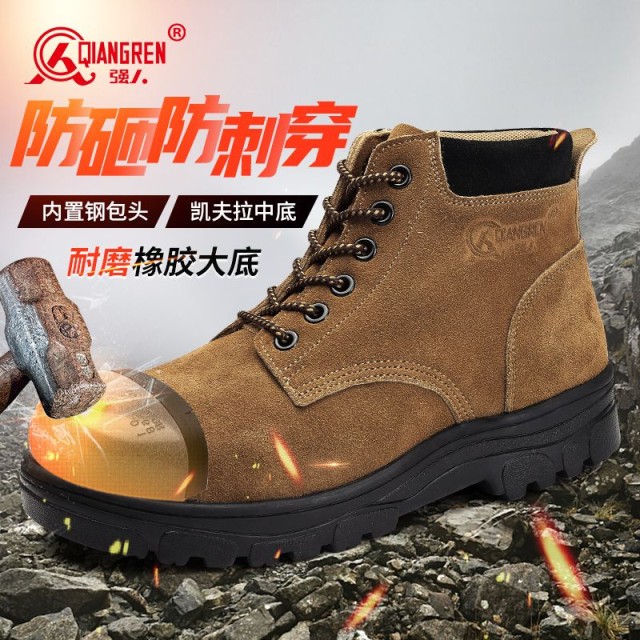When selecting steel toe boots, most workers focus on impact protection—but true workplace safety requires understanding the full spectrum of standards governing electrical hazards, compression risks, and industry-specific threats. This guide decodes global safety certifications and their life-saving implications across industries.
Why Safety Standards Matter in Hazardous Workplaces
Workplace footwear standards exist to prevent three types of injuries:
- Traumatic injuries (e.g., crushed toes from falling objects)
- Cumulative damage (e.g., foot fatigue from inadequate arch support)
- Environmental exposures (e.g., electrocution from conductive materials)
Research shows compliant boots reduce foot injuries by over 60% in high-risk sectors like construction and oil refining. Standards like ASTM, ISO, and EN establish test protocols replicating real-world hazards—from 2,500-pound compression forces to 200-joule frontal impacts.
Key Global Standards: ASTM, ISO, and EN
ASTM F2413 (North America)
- Impact Resistance (I): Toe caps withstand 75 foot-pounds of force
- Compression (C): Protects against 2,500 pounds of static weight
- Metatarsal (Mt): Shields upper foot with 1" clearance during impacts
- Electrical Hazard (EH): Non-conductive materials prevent current flow
Example: Boots marked "ASTM F2413-18 I/75 C/75 Mt EH" meet all four requirements.
EN ISO 20345 (Europe)
- 200J toe protection (equivalent to 20kg dropped from 1m)
- Slip resistance (tested on greased steel surfaces)
-
Specialized codes:
- SRA: Slip-resistant on ceramic tiles with soap
- P: Puncture-resistant midsoles
- E: Heel energy absorption
Regional Variations
- Canada: Combines ASTM with CSA Z195-14
- Australia: AS/NZS 2210.3 mirrors ISO 20345
Beyond Impact Resistance: Critical Protections
Electrical Hazards
ASTM-compliant boots use non-metallic shanks and soles that resist up to 18,000 volts. This prevents ground path electrocution—a leading cause of fatalities in utility work.
Compression Risks
In manufacturing, forklifts and heavy machinery can exert crushing forces exceeding 1 ton. Boots with "C" ratings maintain protective toe space even under extreme weight.
Puncture Threats
Construction sites with exposed nails require soles that withstand 270 Newtons of penetration force (marked "P" in ISO standards).
How to Choose the Right Standard for Your Industry
Construction
- Primary risks: Falling tools, rebar punctures, wet surfaces
- Key standards: ASTM I/C + Mt, ISO 20345:2022 SRA P
Oil & Gas
- Primary risks: Hydrocarbon exposure, electrostatic sparks
- Key standards: ASTM EH, ISO Fo (fuel-resistant soles)
Warehousing
- Primary risks: Forklift compression, slippery floors
- Key standards: ASTM C/75, ISO SRC (dual-surface slip resistance)
Case Studies: How Compliance Prevented Injuries
-
Chemical Plant Explosion (Texas, 2022)
- Workers wearing EH-rated boots avoided electrocution when high-voltage equipment short-circuited.
-
Steel Mill Accident (Germany, 2021)
- ISO 20345-compliant metatarsal guards prevented foot fractures when a 400°C metal sheet fell.
-
Warehouse Collapse (Ontario, 2023)
- ASTM C/75 boots kept toes intact after shelving units collapsed with 1,800 lbs/sq in pressure.
Protect Your Workforce with Certified Safety Footwear
3515 manufactures ASTM and ISO-compliant boots for distributors and bulk buyers across industries. Our safety solutions combine rigorous testing with ergonomic designs—because meeting standards is just the baseline for true protection. [Contact 3515] to outfit your team with boots engineered for your specific hazards.
Products You Might Be Looking For:
View ASTM-compliant steel toe work boots
Explore ISO-certified metatarsal safety boots
Browse EH-rated electrical hazard footwear
Related Products
- Wholesale Customizable Suede Safety Boots - Puncture-Proof with Velcro Closure
- Puncture-Resistant Velcro Safety Boots for Wholesale & Custom Manufacturing
- Customizable Anti-Smash Safety Boots for Wholesale & Private Label Manufacturing
- Wholesale Leather Safety Boots with Customizable Protective Toe
- Durable Leather Safety Boots for Wholesale & Custom OEM Manufacturing
Related Articles
- How to Choose Work Boots That Match Your Industry's Safety Needs
- How to Choose Work Boots That Balance Safety, Comfort, and Durability for Your Job
- How to Choose Work Boots That Match Your Job Demands and Safety Needs
- Work Boots vs. Western Boots: How to Choose the Right Footwear for Labor Safety
- How Safety Work Boots Engineer Protection: Features and Standards for Targeted Hazard Mitigation




















